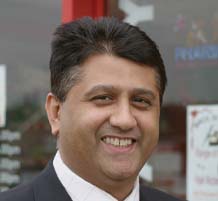Hubs, spokes, and technology
In Views
Follow this topic
Bookmark
Record learning outcomes
In reality, we are very limited in our capacity to operate the technology available that could revolutionise the way we practise
Hub-and-spoke models look set to affect pharmacy practice to a degree that remains unclear. Mukesh Lad, chairman of the LIPCO federated group, discusses whether independents should follow the multiples' lead in this area

The greatest impact on our profession over the next decade is going to come from technology. We already need to keep records of patient care to ensure the safety, quality, consistency and continuity of the service we provide. So our current use of technology, whether simply using a phone or fax machine or engaging with patient information with systems such as PMR or EPOS, is well established in pharmacy practice.
Despite the requirement for pharmacy professionals to create, use and maintain electronic documents and data to the relevant legal requirements, professional standards and governance frameworks, many independents and their staff still struggle with basic email, word processing or spreadsheet programs. In reality, we are very limited in our capacity to operate the technology available that could revolutionise the way we practise.
Smart apps to monitor and control delivery drivers will allow us to improve efficiency. Online training and webinars will change the way we learn and engage with each other. Promoting our business with captivating websites and providing private services via PGDs and online GPs will all contribute to improving our reach in the market.
Controversy on the horizon
Most of the technology I've just mentioned is seen, for the most part, as a positive development. However, one development on the horizon is being treated with great caution €“ the controversial hub-and-spoke dispensing technology.
So what is all the fuss about? The hub-and-spoke model is basically centralised dispensing and the government recently agreed to enter into consultation on legislative change that could allow all community pharmacies to operate under this model.
In essence, it is centralised dispensing that would see any prescription received by a registered pharmacy being transferred to another registered premises for assembly, dispensing and collection by the patient. Alternatively, the medication could be delivered to the patient or returned to the pharmacy where the prescription was originally presented, for patient collection or delivery.
It's a useful model for pharmacy groups that are owned and operated by one legal entity, as it offers the opportunity to improve dispensing efficiency. A central hub with one team concentrating on dispensing regular repeat prescriptions can provide cost savings on labour. Acute walk-in and complex repeat prescriptions would continue to be dispensed by the original 'spoke' site.
By dividing pharmacy labour in this way, greater time and effort can be dedicated to patient care with the delivery of quality clinical and pharmaceutical services. Admittedly, the benefits of such a model have yet to be validated, but many multiples are already starting to invest in this process, with some planning a full rollout across their group by 2018.
A few scaled-down modular and manual versions of the centralised operation are being trialled and used by some independent groups. What elevates the technology to astounding capabilities is the electronic prescription service (EPS). This will enable the automatic electronic transmission of any repeat prescription to a hub for assembly, checking, processing, and then delivery or collection from the spoke site.
Many of the larger multiples with wholesale operations are already piloting the system, processing as many as 100,000 items a day with a turnaround time of between 24 and 48 hours €¦ and this is just the testing phase. These multiples are operating their hubs from the vast warehouses of their wholesale division, allowing the retail pharmacy hub to source any drug that may be required.
Pharmacy leaders are seeing this development as one of the most significant challenges to be faced by community pharmacy in the near future. Many of our professional bodies are questioning the efficiency and capabilities of the proposed hub-and-spoke system. And how can we be sure our patients will continue to get the care they deserve?
I'm sure we will see further tweaking and refining of the model. Perhaps the 'big player wholesalers' will consider subcontracting for a small fee? We could yet see our wholesalers bringing us pre-processed repeat prescription drugs all checked, bagged and ready for collection or delivery. The government consultation is due to launch next year, with legal changes introduced as soon as October 2016.
More collaboration required
This has huge implications for independent pharmacies. We now need to collaborate more than ever, not only in the provision of clinical services but also in dispensing and supply. Could the hub-and-spoke technology pose a threat from efficiency savings that could, in turn, lead to a reduction in dispensing fees? I'm not sure that an independent not participating in the technology would be able to survive the potential reduction in income.
It's too early to speculate on the impact or even the success of hub-and-spoke technology. As we well know, there's no such thing as a one-size-fits-all patient. They're always going to be individuals with specific and diverse needs and I've yet to be convinced that such an automated dispensing process will work at scale across the country.
What we do know, however, is that there is considerable concern around the lack of evidence to support claims of improved efficiency and cost savings. But then, why are so many of the big pharmacy groups investing in it?
